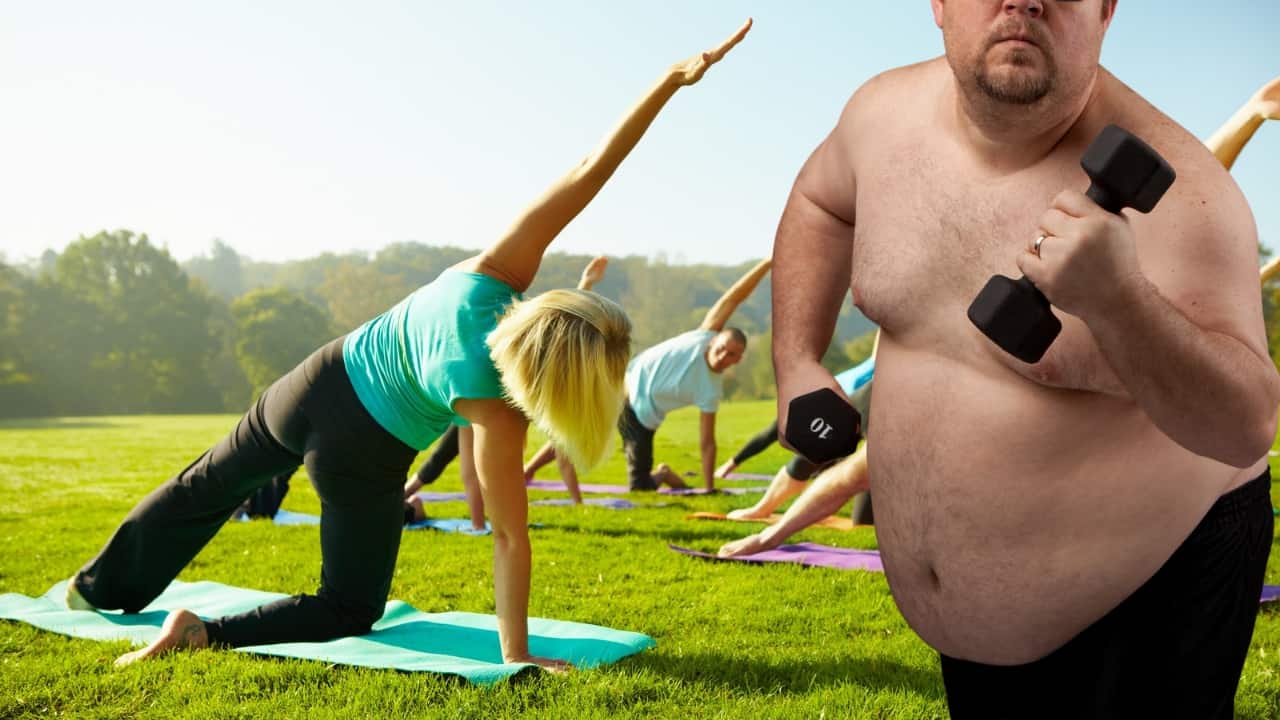Starting a workout program can be intimidating, especially for beginners. However, the benefits of getting in shape are undeniable. Not only will you feel better physically and mentally, but you’ll also decrease your risk of chronic diseases and improve your overall quality of life.
How to Get in Shape Fast
To start getting in shape, it’s important to adjust your eating habits. Focus on a balanced diet that includes lean protein, healthy fats, and complex carbohydrates. Increase your calorie intake to support your body’s energy needs during exercise. Choose foods that are high in fiber to help you feel full and satisfied while maintaining a calorie deficit for weight loss.

In addition to adjusting your diet, it’s important to incorporate exercises into your routine. Fitness classes or gym memberships can provide structure and motivation for those starting out. Circuit training and high-intensity interval training (HIIT) are effective ways to build muscle and increase cardiovascular endurance.
But what if you don’t have access to a gym or fitness classes? You can still get in shape at home! Bodyweight workouts like squats, pushups, and lunges can be performed anywhere without any special equipment. Resistance bands or dumbbells can also be used for strength training.
So how long does it take to get in shape? The answer varies depending on individual goals and starting points. Consistency is key – aim for at least 30 minutes of exercise most days of the week. Gradually up the duration or intensity of your workouts as you advance.
Why should you get in shape? Beyond physical health benefits, regular exercise has been shown to improve mood, reduce stress levels, and boost cognitive function.
Incorporating lean protein sources such as chicken, fish, tofu, and legumes into meals supports muscle growth and repair. Remember that rest days are just as important as exercise days – allow time for muscles to recover between workouts.
Getting in shape may seem daunting at first glance but with consistency and dedication, it is achievable. Therefore, why not start on the path to a better, happier you?
Importance of Consistency and Commitment
Set Realistic Goals for Your Workout Routine
When starting a workout routine, it’s important to set realistic goals. You don’t want to set yourself up for failure by aiming too high right off the bat. Set modest, manageable goals in their place, then build on them.
For example, if you’re just starting out, aim to exercise for 30 minutes three times a week. Once you’ve achieved that goal consistently for a few weeks, increase the frequency or duration of your workouts.
It’s also important to remember that progress takes time. Don’t get discouraged if you don’t see results immediately. Keep pushing yourself and trust the process.
Start with a Simple Routine and Gradually Increase the Intensity
Starting with a simple routine is key when beginning a workout regimen. This will help you establish good habits and prevent injury by allowing your body to adjust gradually to physical activity.
As you become more comfortable with your routine, gradually increase the intensity by incorporating compound movements into your workouts. Compound movements are exercises that work for multiple muscle groups at once, such as squats or lunges. These types of exercises are great for building strength and burning calories efficiently.
Make Exercise a Habit by Scheduling it Into Your Daily Routine
One of the best ways to make exercise a habit is by scheduling it into your daily routine. Treat it like an appointment that cannot be missed or rescheduled. This will help ensure that you prioritize your health and fitness.
Another effective strategy is finding an accountability partner or joining a fitness class. Having someone else hold you accountable can provide motivation on days when you may not feel like working out.
Consistency is Key
When it comes to accomplishing fitness objectives, consistency is essential. It’s better to exercise regularly at a lower intensity than sporadically at high-intensity levels. Consistent effort over time will yield better results than short bursts of intense activity followed by long periods of inactivity.
Never forget that getting fit is a journey, not a destination. It takes time and effort to see results, but with a consistent commitment to your workout routine, you will achieve your goals.
Set Realistic Goals Based on Your Schedule and Lifestyle
Starting a workout program can be intimidating, but it’s important to remember that everyone starts as a beginner.
No matter how daunting the idea of starting a workout program may seem, it’s essential to keep in mind that everyone begins as a novice. Whether you’re new to exercise or returning after an extended hiatus, setting realistic goals is crucial.
By establishing achievable targets based on your schedule and lifestyle, you’ll be more likely to stick with your fitness routine over time.
Fitness classes can be a great way to get started, as they offer guidance and support from a trained instructor.
If you’re unsure where, to begin with your fitness journey, consider taking group fitness classes. Fitness classes are an excellent way to get started because they provide guidance and support from experienced instructors.
Additionally, working out in a group setting can help keep you motivated and accountable for showing up each week. There are many different types of fitness classes available today, ranging from yoga and Pilates to high-intensity interval training (HIIT) and boot camps.
Exercises that focus on circuit training and high-intensity interval training (HIIT) can help build muscle and improve overall fitness.
Circuit training is an excellent way to increase strength while also improving cardiovascular health. This type of exercise involves performing several different exercises in quick succession with little rest between sets.
HIIT workouts are another popular option for those looking to improve their overall fitness levels quickly. These workouts involve short bursts of intense activity followed by periods of rest or low-intensity movement.
Going to the gym is a popular option for those looking to get in shape, but it’s important to find a gym that fits your needs and preferences.
If you prefer working out independently rather than attending group classes, going to the gym might be the right option for you. However, not all gyms are created equal! Take some time researching local gyms in your area before committing to one. Consider factors such as cost, location, equipment availability, and hours of operation when selecting a gym.
Taking the first step towards getting in shape is the most important one, and with dedication and consistency, anyone can achieve their fitness goals.
No matter what your current fitness level may be, taking that initial step toward getting in shape is the most critical part of the process. It’s essential to set realistic goals based on your schedule and lifestyle to ensure that you remain motivated and committed to your routine.
Remember that consistency is key; you’ll be able to reach your goals and maintain a healthy lifestyle for years to come.
Practical Tips for Starting or Restarting a Fitness Routine
Importance of Strength Training for Maintaining Muscle Mass and Bone Density
Regular exercise is essential for maintaining good health, but many people tend to focus solely on cardiovascular exercises like running or cycling. However, strength training is equally important for building muscle mass and maintaining bone density.
As we age, our bodies naturally lose muscle mass and bone density, which can lead to a higher risk of injury and chronic conditions such as osteoporosis.
By incorporating strength training into your workout routine, you can help slow down this process and maintain healthy body composition. This can be achieved through exercises such as weightlifting or bodyweight exercises like push-ups or squats.
It’s important to start with lighter weights or resistance bands if you’re new to strength training and gradually increase the weight as you become more comfortable.
Benefits of High-Intensity Interval Training (HIIT) for Cardiovascular Health and Weight Loss
High-intensity interval training (HIIT) has become increasingly popular in recent years due to its effectiveness in improving cardiovascular health and aiding weight loss.
HIIT involves short bursts of high-intensity exercise followed by periods of rest or lower-intensity activity. This type of workout can be done with various exercises such as sprints, biking, jumping jacks, etc.
Research has shown that HIIT workouts are more effective at burning calories than traditional steady-state cardio workouts like jogging or cycling. Additionally, HIIT has been found to improve insulin sensitivity and reduce blood pressure levels in individuals with type 2 diabetes.
Role of Proper Nutrition in Achieving Fitness Goals
While exercise is an essential component of any fitness routine, proper nutrition is equally important for achieving your goals. A diet rich in lean protein sources such as chicken breast, fish, and tofu helps build muscle mass while whole foods like fruits and vegetables provide essential vitamins and minerals necessary for overall health.
It’s also important to avoid processed foods high in sugar and salt as these can contribute to weight gain and other health issues. Drinking plenty of water is also essential for staying hydrated during workouts.
Benefits of Working with a Personal Trainer or Coach
Working with a personal trainer or coach can be beneficial when starting or restarting a fitness routine. A trainer can help you develop a customized workout plan tailored to your specific goals and fitness level. They can also provide guidance on proper form and technique, which is essential for preventing injuries.
Additionally, a trainer can hold you accountable and provide motivation to stick to your routine. They may also be able to offer nutritional advice and support in developing healthy habits outside of the gym.
Importance of Rest and Recovery
Rest and recovery are important components of any fitness routine but are often overlooked by those starting out. Adequate rest days between workouts are necessary for allowing muscles time to recover, repair, and grow stronger.
Getting enough sleep is also crucial for overall health as it allows the body time to repair itself from the stresses of daily life. If experiencing symptoms such as fatigue or decreased energy levels, it’s important to consult with a healthcare provider as hormonal changes may be impacting your ability to achieve your fitness goals.
Sponsored…
⚡️The Ultimate Keto Meal Plan⚡️
>>> Get 21 Free Keto Recipes (Yummy) >>>
Today, We’ve rounded up 21 of our favorite Keto dishes for breakfast, lunch and dinner. You’re going to want to bookmark this list, as these recipes are totally drool-worthy.
All recipes come with simple ingredients and easy instructions and you can Download everything today for Free.
Sounds good?
==> Just Click Here to Download your FREE copy of 21 Yummiest Keto Recipes.
Your family and friends will love these Keto recipes…
And everything is 100% keto-approved and proven to speed up your ketosis.
Just follow the instructions below and download your Free Keto cookbook 🙂
- Click Here to get to the Download page.
- Enter your details about where to send the recipes.
- Check your email address in the next few minutes (also check your spam filter) and enjoy your new recipes!
Sample 30-Day Workout Challenge for Quick Results
Consistency is Key to Achieving Fitness Goals
Consistency is key. It’s important to commit to a regular workout routine if you want to see results. This means setting aside time each day or week for exercise and making it a priority.
Regular Exercise with Moderate Intensity is More Effective than Sporadic High-Intensity Workouts
While high-intensity workouts can be effective, they’re not always sustainable for the long term. Instead, focus on regular exercise at a moderate intensity level. This might involve exercises like cycling, swimming, or brisk walking.
Compound Movements Provide Better Results
If you’re looking for quick results from your workout routine, consider incorporating compound movements into your exercises. These are movements that engage multiple muscle groups at once, such as squats and deadlifts. By engaging more muscles at once, you’ll burn more calories and build strength faster.
Commitment to a Fitness Routine Leads to Long-Term Health Benefits and Improved Quality of Life
Sticking to a fitness routine isn’t always easy, but the rewards are worth it in the long run. Regular exercise has been linked to a range of health benefits, including improved cardiovascular health, stronger bones and muscles, and reduced risk of chronic diseases like diabetes and cancer.
Sticking to a Workout Plan Can Be Challenging, But the Rewards Are Worth the Effort
One of the biggest challenges is to try setting small goals for yourself along the way – whether that’s running an extra mile or lifting heavier weights – so that you can see progress over time.
Incorporate Variety Into Your Workout Routine
To keep things interesting and prevent boredom from setting in during your workouts, incorporate variety into your routine. This could mean trying out new exercises or activities every few weeks or changing up your routine entirely every few months.

Nutrition Adjustments to Help You Get in Shape
Analyze Your Daily Routine and Identify the Time Slots Available for Exercise
The first step in getting in shape is to analyze your daily routine and identify the time slots available for exercise. This will help you determine when you can fit exercise into your schedule without disrupting other important activities.
For example, if you have a busy work schedule, it may be best to exercise early in the morning or late at night. If you have children, you may need to coordinate with their schedules to find time for exercise.
Once you have identified the best time slots for exercise, it’s important to stick to them consistently. This will facilitate routine setting and make it simpler to include exercise in your daily life. It’s also important to set achievable goals that match your fitness level and schedule.
Set Achievable Goals That Match Your Fitness Level and Schedule
Setting achievable goals is essential when starting an exercise program. It’s important to start small and gradually increase the difficulty of your workouts as your fitness level improves. This will help prevent burnout or frustration from setting unrealistic expectations.
When setting goals, consider what type of exercise suits your lifestyle best. For example, if you prefer working out at home, there are many online resources available that offer home workout routines that require little or no equipment.
If you prefer going to a gym, research local gyms and find one that fits your budget and location preferences.
Be Flexible and Adjust Your Goals When Necessary
It’s important to be flexible when pursuing any goal, including getting in shape. Life can be unpredictable, so it’s essential to adjust your goals when necessary. For example, if an unexpected event disrupts your workout routine for a few days or weeks, don’t give up on exercising altogether.
Instead, adjust your goals accordingly by reducing the frequency or intensity of workouts until you can resume regular activity.
In addition to adjusting workout routines when necessary, it’s also essential to pay attention to eating habits. To get in shape, it’s important to consume more calories than you burn through exercise.
This means incorporating lean protein, fruits, and vegetables into your diet while reducing processed foods and sugary drinks.
What to Eat to Get in Shape
The focus should be on consuming a balanced diet that includes plenty of lean protein, healthy fats, complex carbohydrates, and fiber. Lean protein sources such as chicken breast, fish, tofu, and legumes can help build muscle mass and aid in weight loss.
Fruits and vegetables are also essential for getting in shape because they provide essential vitamins and minerals while keeping you full longer. Complex carbohydrates such as whole grains are an excellent source of energy for workouts while fiber helps regulate digestion.
What Do Actors Eat to Get in Shape?
Many actors follow strict diets when preparing for roles that require them to be in top physical condition. These diets typically include plenty of lean protein sources such as chicken breast or fish along with leafy greens and other vegetables.
Some actors also incorporate intermittent fasting into their diets by limiting their eating window to a few hours each day. This can help reduce calorie intake without sacrificing necessary nutrients.
Opportunities to Strengthen Your Body in Your Environment
Gain Strength and Improve Your Body with the 30-Day Workout Challenge
Mixing up your workout routine can be a great way to challenge your body, prevent boredom, and achieve new goals. If you’re looking to gain strength and improve your overall fitness level, the 30-day workout challenge may be just what you need.
Designed to help you achieve quick results in just one month, this challenge includes a mix of cardio and strength training exercises to target different muscle groups and improve overall fitness. Each day of the challenge features a different workout routine, with increasing intensity as the month progresses.
Day 1-10: Building a Strong Foundation
The first ten days of the challenge are focused on building a strong foundation for your workouts. You’ll start with basic moves like squats, lunges, push-ups, and planks. These exercises will help you build endurance and prepare your muscles for more intense workouts later in the month.
Days 11-20: Increasing Intensity
As you move into the second phase of the challenge, you’ll start to increase the intensity by adding weights or resistance bands to your exercises. You might also incorporate high-intensity interval training (HIIT) into your routine to boost calorie burn and improve cardiovascular health.
Days 21-30: Challenging Your Limits
During the final stretch of the challenge, you’ll really push yourself to reach new limits. You might try more advanced exercises like burpees or pull-ups, or add more weight to your lifts. The goal is to keep challenging yourself so that you continue seeing progress throughout the month.
By following this 30-day workout consistently, you can expect to see improvements in your endurance, strength, and body composition. Not only will you feel stronger physically but mentally as well since exercise has been shown to reduce stress levels and boost mood.
Incorporating strength training into your fitness routine is an important part of achieving long-term health and wellness. By challenging your muscles with resistance training, you can improve bone density, reduce the risk of injury, and increase overall strength and mobility.
If you’re looking to gain strength and improve your body, try incorporating the 30-day workout challenge into your routine. Remember to listen to your body, stay hydrated, and fuel yourself with nutritious foods to support your workouts. With consistency and dedication, you can achieve great results in just one month!
HIIT Workouts: Why You Should Try Them
Incorporate bodyweight exercises into your routine to gain strength without equipment
Bodyweight exercises are a great way to build strength and endurance without the need for any equipment. These types of exercises use your own body weight as resistance, making them a convenient and effective option for those who don’t have access to gym equipment or prefer working out at home.
Some popular bodyweight exercises include push-ups, squats, lunges, and planks. These exercises can be modified to suit different fitness levels and goals. For example, beginners can start with modified push-ups on their knees while more advanced individuals can try one-arm push-ups.
Utilize household items such as water bottles or chairs for resistance during strength training
If you’re looking to add some extra resistance to your workouts but don’t have access to traditional weights, there are plenty of household items that can be used instead. Water bottles filled with sand or books can be used as dumbbells for arm exercises, while chairs or walls can provide support for squats and lunges.
Using household items as resistance not only saves money but also adds variety to your workout routine. You can experiment with different objects and movements to challenge different muscle groups and keep things interesting.
Take advantage of outdoor spaces like parks or trails for Bodyweight workouts or Cardio exercises
Working out in nature provides numerous benefits beyond just physical exercise. Being outdoors has been shown to reduce stress levels, improve mood, and increase overall well-being. Plus, it’s completely free!
Parks and trails offer endless opportunities for bodyweight workouts such as pull-ups on monkey bars or using benches for step-ups. Running or biking on trails is also an excellent form of cardio that allows you to enjoy the scenery while getting a great workout in.
Join a local sports team or fitness class to challenge and strengthen your body in a social setting
Exercise doesn’t have to be a solitary activity – joining a sports team or fitness class can provide a social and motivational aspect to your workouts. Playing team sports such as soccer or basketball not only improves cardiovascular health but also develops coordination, agility, and teamwork skills.
Fitness classes like yoga or Pilates offer a low-impact way to improve flexibility, balance, and core strength. Plus, the group setting allows for accountability and support from classmates.
Make small changes to your daily routine, such as taking the stairs instead of the elevator, to increase overall physical activity and improve body strength
Incorporating more physical activity into your daily routine is an easy way to improve overall health without having to set aside dedicated workout time. Simple changes like taking the stairs instead of the elevator or parking farther away from your destination can add up over time.
These small changes not only increase physical activity levels but also help build muscle strength and endurance. Over time, you may find that these habits become second nature and lead to even more lifestyle changes toward a healthier life.
Talk to Your Doctor Before Starting a Fitness Program
It is important to talk to your doctor before starting a fitness program.
Told Healthline, consulting with a doctor can help identify any underlying health conditions that may affect your ability to exercise. It is crucial to understand your body’s capabilities and limitations before engaging in any physical activity.
A thorough medical examination can reveal potential risks associated with specific exercises or activities.
Your doctor can also provide guidance on the types of exercises that are safe and appropriate for your fitness level and health status. They can recommend exercises based on your age, weight, medical history, and current physical condition.
For example, if you have a history of back pain, they might suggest low-impact exercises such as swimming or yoga instead of high-impact activities like running or jumping jacks.
Additionally, they can help you set realistic goals and create a plan that takes into account any medical concerns or limitations. Your doctor will work with you to develop an exercise regimen that fits within your lifestyle while still challenging you enough to achieve results.
They might also suggest modifications to certain exercises or recommend alternative workouts if necessary.
By talking to your doctor before starting a fitness program, you can ensure that you are taking the necessary steps to protect your health and achieve your fitness goals safely. This is especially important if you have pre-existing health conditions such as heart disease, diabetes, or arthritis.
Exercise can be beneficial for these conditions but must be approached carefully with guidance from a medical professional.
Achieving Your Goals to Get in Shape
Set Specific and Measurable Fitness Goals to Track Your Progress
Setting specific and measurable fitness goals is essential to achieving your fitness objectives. Without a clear target, it can be challenging to track your progress and stay motivated. When setting your goals, make sure they are attainable, relevant, and time-bound.
For example, instead of saying “I want to lose weight,” set a specific goal such as “I want to lose 10 pounds in the next three months.” This goal is specific because it includes a defined amount of weight loss within a given timeframe. It’s also measurable since you can track your progress over time.
Once you have set your goals, write them down and keep them visible so that you can remind yourself why you started on this journey in the first place. Celebrate small victories along the way and adjust your plan if necessary to ensure that you’re still on track.
Incorporate a Variety of Workouts
Incorporating a variety of workouts into your routine is crucial for improving overall fitness. Aerobic exercise helps improve cardiovascular health, while strength training builds muscle mass and improves bone density.
Try to mix up your workouts by incorporating activities such as running, cycling, swimming, or dancing. Strength training exercises like push-ups, squats, or lunges can be done at home without any equipment.
Consider Working with a Fitness Trainer or Personal Trainer
Working with a fitness trainer or personal trainer can help you develop a tailored workout plan based on your individual needs and goals. They can also provide guidance on proper form and technique during exercises to prevent injury.
A trainer can help hold you accountable for sticking with your program by providing motivation and encouragement when needed. They may also offer nutritional advice that complements your workout routine for optimal results.
Find a Workout Buddy or Join a Coaching Program
Finding a workout buddy or joining a coaching program is another great way to stay motivated and accountable. Having someone else who shares your fitness goals can help you stay committed and on track.
Coaching programs offer a structured approach to fitness with a group of people who are all working towards similar goals. This can be an effective way to stay motivated, receive support from others, and learn new techniques or exercises.
Adopt a Healthy Lifestyle to Get in Shape
Adopting a healthy lifestyle to Get in Shape is crucial for achieving long-term fitness goals. Making small changes to your diet, such as reducing processed foods and increasing whole foods like fruits, vegetables, lean proteins, and whole grains can make a significant difference in overall health.
Incorporating regular exercise into your daily routine is also essential for maintaining good health. By making exercise a habit, it becomes easier to stick with over time. Remember that consistency is key when it comes to achieving any fitness goal.
Getting in Shape at 40

Losing Weight is Crucial for Getting Fit While Overweight
If you’re over 40 and looking to get in shape, losing weight should be a top priority. Being overweight can lead to a host of health problems, including heart disease, diabetes, and high blood pressure. However, losing weight isn’t just about looking better or avoiding health problems; it’s also about feeling better and having more energy.
One way to lose weight is through a combination of diet and exercise. Eating a healthy diet that’s rich in fruits, vegetables, lean protein, and whole grains can help you shed pounds while providing your body with the nutrients it needs. Exercise is also important for weight loss as it helps burn calories and build muscle.
Bodyweight Exercises are a Great Way to Start Exercising Without Putting Too Much Strain on the Body
If you’re new to exercise or haven’t worked out in a while, starting with bodyweight exercises can be an excellent way to ease into fitness without putting too much strain on your body. Bodyweight exercises use your own body weight as resistance rather than relying on weights or machines.
Some examples of bodyweight exercises include push-ups, squats, lunges, planks, and jumping jacks. These exercises can be done anywhere without any equipment needed.
Nerd Fitness Offers Resources and Programs Specifically Designed for Overweight Individuals Looking to Get in Shape
If you’re looking for more guidance on getting in shape at 40 or older while overweight, Nerd Fitness offers resources and programs specifically designed for individuals in this situation. Their approach focuses on sustainable lifestyle changes rather than quick fixes or fad diets.
Their coaching program includes personalized support from certified coaches who specialize in working with overweight clients. They also offer online courses that cover topics such as nutrition, strength training, and mindset.
Cutting Out Unhealthy Fats from Your Diet Can Greatly Aid in Weight Loss and Getting Fit While You’re Overweight
Exercise Regularly to Burn Calories and Build Muscle
One of the most effective ways to lose weight is by exercising regularly. When you exercise, your body burns calories, which helps you lose fat. Additionally, regular exercise can help you build muscle, which can increase your metabolism and help you burn even more calories.
If you’re overweight or obese, it’s important to start with low-impact exercises that won’t put too much strain on your joints. Bodyweight exercises like squats, lunges, and push-ups are great options because they don’t require any equipment and can be modified to fit any fitness level.
As you get stronger and more comfortable with these exercises, you can gradually increase the intensity and add weights or resistance bands for an extra challenge.
It’s also important to mix up your workouts to prevent boredom and keep your body guessing. Try incorporating different types of cardio like walking, swimming, or cycling into your routine. This will not only help you burn calories but also improve your cardiovascular health.
Eat a Balanced Diet with Plenty of Protein, Fruits, and Vegetables
While exercise is important for weight loss, diet plays an even bigger role in achieving lasting results. To lose weight while still maintaining muscle mass, it’s crucial to eat a balanced diet that includes plenty of protein-rich foods like chicken breast, fish, eggs, beans, and lentils.
In addition to protein, make sure to include plenty of fruits and vegetables in your diet as well. These nutrient-dense foods are low in calories but high in fiber and other essential vitamins and minerals that can support overall health.
On the other hand, it’s important to avoid processed foods that are high in unhealthy fats and added sugars. Instead of reaching for chips or candy when hunger strikes between meals try snacking on fresh fruit or veggies instead.
Get at Least 7 Hours of Sleep Each Night
Getting enough sleep is crucial for overall health but it’s especially important when you’re trying to lose weight. When you don’t get enough sleep, your body produces more of the hormone cortisol, which can increase appetite and make it harder to stick to a healthy diet.
To ensure you’re getting enough rest, aim for at least 7 hours of sleep each night. If you have trouble falling or staying asleep, try incorporating relaxing activities like yoga or meditation into your evening routine.
Consider Incorporating Stress-Reducing Activities
Stress can be a major obstacle in achieving weight loss goals. When you’re stressed out, your body produces more cortisol which can lead to increased appetite and cravings for unhealthy foods.
To combat stress and improve overall health, consider incorporating stress-reducing activities like yoga or meditation into your routine. These practices have been shown to lower cortisol levels and improve mood, making it easier to stick to a healthy diet and exercise plan.
How To Get In Shape Using Psychology
Start with low-impact exercises to avoid injury and gradually increase intensity over time.
To get in shape, it’s important to start with low-impact exercises that won’t put too much strain on your body. This is especially true if you’re new to working out or haven’t exercised in a while. Some good examples of low-impact exercises include walking, swimming, cycling, and yoga. These activities are gentle on your joints and muscles, making them ideal for beginners.
As you progress in your fitness journey, you can gradually increase the intensity of your workouts. For example, if you’ve been walking for 30 minutes a day, try jogging for a minute or two during your next workout. Over time, you can increase the amount of jogging until you’re running for the entire 30 minutes.
Incorporate strength training to build muscle mass and boost metabolism.
Strength training is an essential component of any fitness program. By lifting weights or doing bodyweight exercises like push-ups and squats, you’ll build muscle mass and boost your metabolism. This means that even when you’re not exercising, your body will burn more calories than it would if you didn’t have as much muscle mass.
When starting a strength training program, it’s important to work with a qualified trainer who can show you proper form and technique. This will help prevent injuries and ensure that you’re getting the most out of each exercise. As with any type of exercise program, be sure to start slowly and gradually increase the weight or resistance as your strength improves.
Set achievable goals and track progress to stay motivated.
Setting achievable goals is key to staying motivated when trying to get in shape. Whether it’s losing 10 pounds or running a 5K race, having a specific goal in mind can help keep you focused on your fitness journey. Be sure to set realistic goals that are achievable within a reasonable timeframe.
Tracking your progress is also important for staying motivated. This can be as simple as keeping a log of your workouts or using a fitness app to track your progress. Seeing how far you’ve come can be incredibly motivating and help you stay on track when the going gets tough.
Make lifestyle changes such as improving diet and getting enough sleep to support fitness goals.
Finally, it’s important to make lifestyle changes that support your fitness goals. This includes improving your diet by eating more fruits, vegetables, lean protein, and whole grains while reducing your intake of processed foods and sugary drinks. Getting enough sleep is also crucial for overall health and well-being, as it helps regulate hormones that control hunger and metabolism.
Incorporating healthy habits like these into your daily routine can help support your fitness goals and improve your overall health and well-being. Remember that getting in shape is a journey, not a destination, so be patient with yourself and celebrate each small victory along the way.
Pros and Cons of Getting in Shape
Pros
Getting in shape has numerous benefits for your physical health, energy levels, and sleep quality. Regular exercise can help reduce the risk of chronic diseases such as heart disease, stroke, and diabetes. It can also improve your cardiovascular health and strengthen your bones and muscles.
In addition to the physical benefits, getting in shape can also boost your mental health. Exercise releases endorphins that can help reduce stress and anxiety while increasing feelings of happiness and well-being. Improved sleep quality is another benefit of getting in shape; regular exercise can help you fall asleep faster and stay asleep longer.
Cons
While there are many benefits to getting in shape, it does require time and effort. You may need to give up certain foods or activities that are not conducive to a healthy lifestyle. Staying motivated can also be a challenge; it’s important to find ways to stay engaged with your fitness routine so that you don’t lose interest.
Best Way to Get In Shape
The best way to get in shape is by finding a form of exercise that you enjoy and can stick to. This could be anything from running or cycling to swimming or weightlifting. Setting realistic goals is also important; don’t expect overnight results but rather make gradual changes over time.
Making changes to your diet and lifestyle is also crucial to put vegetables, lean protein sources, and whole grains into your meals while cutting back on processed foods high in sugar, salt, and unhealthy fats.
Reasons Why People Struggle To Get In Shape
There are many reasons why people struggle with getting in shape. Lack of motivation is one common reason; it’s easy to get discouraged when results aren’t immediate or visible right away. Busy schedules can also make it difficult for people to find time for exercise or meal prep.
Unhealthy habits such as smoking or excessive alcohol consumption can also hinder progress when it comes to getting in shape. Unrealistic expectations can also be a barrier; don’t expect to lose 20 pounds in a week or run a marathon after only a few days of training.
Successful Fitness Journeys
Many individuals have succeeded in their fitness journeys by making small changes over time. For example, starting with just 10 minutes of exercise per day and gradually increasing the duration and intensity as they become more comfortable.
Others have found success by incorporating healthy habits into their daily routines such as taking the stairs instead of the elevator or packing healthy snacks for work.
Thumb Rule for Exercise
To get in shape, aim for at least 30 minutes of moderate-intensity exercise per day, five days a week. This could include brisk walking, jogging, cycling, swimming, or any other activity that gets your heart rate up and makes you break a sweat.
How to Get back in Shape after years of inactivity
Find Your Motivation
Finding something that motivates you to stay committed is key. This can be anything from wanting to improve your health and fitness for the sake of your family, to wanting to feel more confident in your own skin.
Whatever your motivation may be, it’s important to keep it at the forefront of your mind as you embark on this journey. Write down your goals and post them somewhere visible so that you’re constantly reminded of what you’re working towards.
Find a Workout Routine That Fits Your Lifestyle
One of the biggest challenges people face when trying to get back in shape is finding a workout routine that fits their lifestyle. If you have a busy schedule, it can be tough to find time for exercise.
The good news is that there are plenty of options out there that can work for even the busiest of people. Whether it’s taking a walk during lunch breaks or doing a quick workout before bed, finding a routine that works for you is crucial.
It’s also important to mix things up and try new types of exercises. This will not only help prevent boredom but will also keep your body challenged and help you see results faster.
Find a Healthy Eating Plan That Works for You
In addition to exercise, eating healthy is also essential when trying to get back in shape. However, with so many diets and nutrition plans out there, it can be overwhelming to figure out where to start.
The key is finding an eating plan that works for you and sticking with it. This doesn’t necessarily mean following strict rules or cutting out entire food groups – instead, focus on making small changes like swapping out processed snacks for healthier options or incorporating more fruits and vegetables into your meals.
Remember that consistency is key when it comes to nutrition – one healthy meal won’t make up for days of unhealthy eating.
Find Support
Finally, having support along the way can make all the difference when trying to get back in shape. Whether it’s finding a workout buddy or joining a fitness community, having others to hold you accountable and cheer you on can be incredibly motivating.
It’s also important to celebrate your achievements along the way – whether it’s hitting a new personal best at the gym or sticking to your healthy eating plan for a full week. These small wins can help keep you motivated and remind you of how far you’ve come.
Set Specific, Achievable Goals
One of the best ways to stay motivated and track your progress when trying to get in shape is by setting specific, achievable goals for yourself. Whether you want to lose a certain amount of weight or be able to run for a certain distance without stopping, having a clear goal in mind can help keep you focused and on track.
To set effective goals, it’s important to make them specific and measurable. For example, instead of saying “I want to lose weight,” try setting a goal like “I want to lose 10 pounds in the next 3 months.” This gives you a clear target to work towards and allows you to measure your progress along the way.
It’s also important that your goals are achievable. While it’s great to aim high, setting unrealistic goals can quickly lead to frustration and disappointment. Make sure that your goals are challenging but still within reach so that you can stay motivated as you work towards them.
Use Positive Self-Talk and Visualization Techniques
Getting in shape isn’t just about physical fitness – it also requires mental strength and resilience. One way to build this mental toughness is by using positive self-talk and visualization techniques.
Positive self-talk involves consciously replacing negative thoughts with positive ones. For example, if you find yourself thinking “I’ll never be able to do this,” try reframing that thought into something more positive like “I’m making progress every day.”
Visualization techniques involve picturing yourself achieving your goals in vivid detail. This can help build confidence and overcome mental barriers as you work towards your desired outcome.
Create a Support System
Having support from friends or family members can make all the difference when trying to get in shape. Consider enlisting the help of a workout buddy who shares similar goals or hiring a personal trainer who can provide guidance and accountability.
If neither of these options is feasible for you, consider joining a fitness class or online community where you can connect with others who are also working towards their fitness goals. Having a support system can help keep you motivated and on track, even when the going gets tough.
Incorporate Enjoyable Physical Activities
Finally, it’s important to find physical activities that you enjoy in order to increase adherence and reduce stress. Whether it’s dancing, hiking, or playing a sport, incorporating enjoyable physical activities into your routine can make it easier to stick with your fitness goals over the long term.
Remember that getting in shape is a journey, not a destination. By setting specific goals, using positive self-talk and visualization techniques, creating a support system, and incorporating enjoyable physical activities into your routine, you can stay motivated and achieve lasting success in your fitness journey.
Set a Specific Goal and Create a Realistic Plan
Before starting any fitness journey, it’s important to set a specific goal and create a realistic plan to achieve it. This could be anything from losing weight to building muscle or increasing endurance. Whatever your goal may be, make sure it is specific, measurable, achievable, relevant, and time-bound.
Once you have set your goal, create a plan that works for you. This could include scheduling workouts into your daily routine or finding a workout buddy to keep you accountable. It’s important to remember that everyone’s fitness journey is different and what works for one person may not work for another.
Incorporate Strength Training into Your Workout Routine
Incorporating strength training into your workout routine is crucial for building muscle and increasing metabolism. Not only does strength training help with weight loss, but it also helps with injury prevention and overall health.
When starting out with strength training, start with lighter weights and gradually increase the weight as you become more comfortable. Focus on compound exercises such as squats, deadlifts, bench presses, and pull-ups which work for multiple muscle groups at once.
Increase Your Cardio Activity Gradually
Increasing your cardio activity gradually is important for improving endurance and burning more calories. When starting out with cardio exercise such as running or cycling, start with shorter durations of around 20-30 minutes per session and gradually increase the duration over time.
It’s also important to mix up your cardio activities to prevent boredom and plateauing. Try incorporating high-intensity interval training (HIIT) into your routine which involves short bursts of intense exercise followed by periods of rest.
Make Dietary Changes
Making dietary changes is just as important as exercising vegetables, lean protein sources, whole grains, and nuts/seeds.
Increasing protein intake can also help with muscle building and weight loss. Aim for at least 1 gram of protein per pound of body weight. Staying hydrated by drinking plenty of water is also important for overall health and recovery.
Get Enough Sleep
Getting enough sleep is crucial for allowing your body to recover and reducing stress levels. Aim for at least 7-8 hours of sleep per night and try to maintain a consistent sleep schedule.
Staying Consistent with Your Fitness Routine
Staying consistent with your fitness routine is key to achieving your goals. Track progress by taking measurements, and photos, or keeping a workout journal to stay motivated.
Remember that fitness is not an overnight process but rather a journey that requires dedication and hard work. With the right mindset and plan in place, you can take your fitness journey to the next level.
FAQ: How to Get in Shape Fast: 30-Days Guide
Q. What are the major benefits of following your 30-day guide for getting in shape fast?
A. Following our 30-day guide will help you get in shape fast in multiple ways. In just 30 days, you can expect to see a dramatic transformation in your body and overall health. You’ll find improved stamina and endurance, greater strength and power, increased flexibility and balance, elevated fat loss, better sleep quality, and improved moods. Plus, it’s all within reach if you commit to the program!
Q. Can I follow this program if I have a busy work schedule or limited access to gym equipment?
A. Absolutely! You don’t need to have a lot of time or fancy equipment to get in shape fast with our program. All you need is determination and the ability to follow instructions. We offer simple exercises you can do anywhere, anytime so that you can stay motivated and get the results you want even if your schedule is hectic.
Q. Will this program help me develop healthy habits and maintain my fitness level over time?
A. Absolutely! Our program is designed to help you develop healthy habits that will support you in the long run, not just help you reach your goals quickly. We will help you develop a sustainable nutrition and exercise plan that can be sustained over time as well as teach you how to stay motivated and stay on track with your fitness goals.
Q. How much weight loss can I realistically expect after completing the 30-day guide?
A. Weight loss goals can vary depending on individual circumstances, however, our program is designed to help you lose 1-3 lbs a week. This means that after completing the 30-day guide you can expect to see anywhere from 3-9 lbs of weight loss. Keep in mind that proper diet and exercise along with following the steps in the program are essential for long-term success.
Q. How do I get back in shape after years of inactivity?
A. Nothing is easy, but getting back in shape after years of inactivity doesn’t have to be daunting. Start off small by committing yourself to exercise for a few minutes each day and gradually increasing the length of your workouts. Track your progress and push yourself forward with every successful step you take. You’ll have to make some dietary changes too, so don’t forget to cut out unhealthy foods and add more nutritious meals into your diet. With enough dedication, you will get back into shape fast!
Q. What does being in shape mean?
A. Being in shape means having the right combination of strength and cardiovascular fitness. You want to be able to move quickly and efficiently, while also being prepared for any physical activity that life may throw at you. With our product, How to Get in Shape Fast, we provide a variety of exercises that you can follow in order to get into tip-top shape. We also offer dietary advice and exercises that help. So don’t hesitate! Get started on your journey toward achieving peak physical performance today.
Conclusion:
Achieving Your Goals to Get in Shape
Getting in shape is a journey that requires consistency, commitment, and realistic goals. It’s not just about looking good; it’s about feeling healthy and strong both physically and mentally. By incorporating practical tips such as setting realistic goals based on your schedule and lifestyle, starting or restarting a fitness routine, adjusting your nutrition, and trying out HIIT workouts, you can achieve the results you want.
It’s important to remember that getting in shape is not a one-size-fits-all approach. Everyone has different needs and abilities. Don’t compare yourself to others or get discouraged if you don’t see immediate results. Instead, focus on small victories along the way and celebrate your progress.
If you’re over 40 or overweight, it may be more challenging to get started but it’s never too late to begin. Talk to your doctor before starting any fitness program to ensure safety and effectiveness.
Incorporating psychology into your fitness routine can also help with motivation and overcoming obstacles. Visualize yourself achieving your goals and use positive self-talk to stay motivated.
Remember that balance is key to diet and sleep. Make adjustments as needed based on how your body responds.
Finally, seek support from friends or family members who share similar goals or consider hiring a personal trainer for guidance.
By following these tips and staying committed to your journey of getting in shape, you’ll achieve the results you desire both physically and mentally. Keep pushing forward toward a healthier lifestyle!

Hey, I am a multifaceted professional excelling in the realms of blogging, YouTube content creation, and entrepreneurship.
With a passion for sharing knowledge and inspiring others, I established a strong presence in the digital sphere through his captivating blog articles and engaging video content.





2 thoughts on “How to Get in Shape Fast: 30-Days Guide”